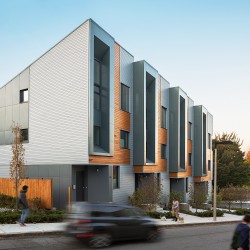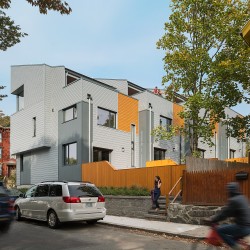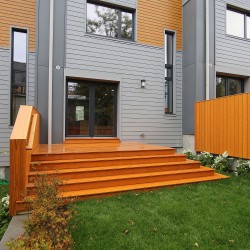Project Subtitle:
Project Description:
The E+ Green Building Program is an intiative the City of Boston / Boston Redevelopment Authority purposed to proving the feasibility of regenerative multi-unit residential buildings and to building energy and environmentally positive homes in Boston’s neighborhoods. 226 - 232 Highland Street is the first building completed in phase one of the Program.
My family could afford to buy and own this house because of its passive design and E+ rating. Although we didn’t realize it when we bought it, owning an e-positive house not only reduces our cost of ownership by lowering our energy expenses, it generates sufficient revenue to more quickly pay down our mortgage. (Ted Resnikoff, Owner, 226 Highland St).
Urbanica Development and ISA Architects, the developer / design team, were selected through a competitive design competition held by the Boston Redevelopment Authority.
A POSITIVE smaller footprint
Our goal is to create low-cost, energy-positive, and environmentally sustainable multi-family housing that stands as a model of responsible, contextual residential development.
Based in a holistic approach toward sustainability, using both low and high technologies in creative, efficient ways at all levels. However, it is the belief of the team that sustainability is not simply a technological fix, but a reconceptualizing of our outlook on the relationship between ourselves, the environment, and our lifestyle. The goal thus was to promote housing that actively engages residents with their local environment, neighborhood, city, and region. By re-evaluating and investing in our existing neighborhoods, they may become denser, more diverse, and more active while maintaining a smaller footprint on the earth.
Project Description
226 - 232 Highland Street is an adaptable townhome building that is a replicable prototype of efficient residential construction for Boston and similar cities through the Northeast. The building consists of four three-bedroom units, each approximately (1970 SF), in a row house configuration.
The building’s form and orientation serve to maximize natural daylight and solar gain for the photo-voltaic arrays that annually generate more electricity than is needed on site. The approach includes two major strategies for energy reduction: first, a super insulated envelope minimizes heat transfer without relying on mechanical conditioning techniques; second, feedback mechanisms that provide information and prompt to users in the house regarding their energy-related activities. The project is thus efficient in energy, resources, use, and space throughout.
embue Intelegent Buildings provides active monitoring of energy consumption and production for the each unit owner and public facing E+ Dashboard at: https://secure.embue.com/eplus-dashboard/.
The four unit project annually surpluses over 8,000 kWh of electricty, returning to the grid enough energy to annually power a typical code compliant home.
Building Type Summary:
Other Awards:
2015 AIA COTE Top Ten Award Winner
Address:
Elevation:
Lat. / Long.:
Location Type:
Köppen Climate Type:
Climate Region:
Solar Insolation:
Annual HDD :
Annual CDD:
HDD Base Temp:
CDD Base Temp:
Occupancy Type and Details:
Four owner occupied residential units. Each is three bedrooms. Family sizes range from 2 to 4.
Conditioned Floor Area:
Conditioned Building Volume:
Semiconditioned Floor Area:
Unconditioned Floor Area:
Multiple buildings?:
Total number of units in project (all buildings):
Total floor area of project (all buildings):
Historic?:
Completion date:
Site description:
Fronting on Marcella St., Highland St., and Fulda St., the site gradually slopes up from Marcella St. to Fulda St. The site was vacant at the time of redevelopment however records from 1899 show a multiple residential buildings tightly fitted on the site.
Materials:
Primary construction materials are regionally sourced dimensional lumber and a fiber cement rainscreen exterior panels. Interior finishes feature products made from sustainably harvested woods, rapidly renewable resources, and high recycled content. Wherever possible, locally sourced materials were selected. Drought-resistant native plantings are used throughout the site. Turf is minimized and a Drought Tolerant Fescue ground cover is used to eliminate and reduce irrigation needs. Rainwater harvesting is used for to irrigate gardens and plantings.
Energy Highlights:
embue Building Intelligence provides each owner with active building energy consumption and production data with a local and mobile interface.
No additional, special, or unusual energy systems or strategies were required.
HERS Index:
Energy Star Score:
Annual renewable energy generated:
Electric Utility Company:
Gas Utility Company:
Datasets and Utility Bills sources and reliability:
Activity utility meter readings. Highly reliable.
Electricity amount (imported from grid):
Electricity amount (credited or exported to grid):
Net electricity usage (purchased electricity):
Natural gas amount (purchased energy):
Energy Storage Capacity:
Energy Storage type:
None.
CHP System Description:
None
Subslab assembly:
Unconditioned crawl space with vapor barrier with crush stoned at grade.
Slab edge assembly:
NA
Foundation wall assembly:
10" steel reinforced concrete.
Above grade wall assembly:
12” double 2×4 - 24" OC wood stud wall with Zip system sheathing and Siga taping and fiber cement siding on furring. Wall cavity filled with dense-packed cellulose and interior drywall finish.
Flat attic assembly:
14’’ TJI with 3/4 plywood sheathing. Cavity filled with dense-packed cellulose and interior drywall finish.
Cathedral ceiling assembly:
14’’ TJI with Zip system sheathing and Siga taping + R-15 rigid above. Cavity filled with dense-packed cellulose and interior drywall finish.
Door Area:
Space heating - Manufacturer & Model:
Space heating - capacity:
Space cooling - Manufacturer & Model:
Space cooling - capacity:
Domestic hot water - Manufacturer & Model:
Domestic hot water - capacity:
Ventilation - Manufacturer & Model:
Process:
The project is the result of the Boston Redevelopment / City of Boston E+ Green Building Program. The design / development team was selected through a competitive design process that challenged leading practitioners to envision and building the next generation of residential urban structures. Integrated project planning was a competition requirement and included utilization and submission of a HERS model with the proposal. Upon designation the project team held a charrette with city staff leading the initiative. The developer worked with the New England Council of Carpenters to utilize the project as a learning and training site for apprentice carpenters.
Design for Adaptability:
The buildings are designed to last over 100 years.
Other Software tools:
Auto CADD
Energy Modeling Software:
REM/Rate - Residential Energy Analysis and Rating Software v14.3
Outcome of project goals:
The primary objects were to build LEED Platinum, net energy positive, urban residences that were market feasible and replicable.
Discrepancies:
No. Of interest is that building performance has improved in the second year as owners fine tune their management and use of the building.
Total Cost of Project:
Construction hard cost:
Published References:
City of Boston web site: http://www.epositiveboston.org/?page_id=812
embue Energy Positive Building Dashboard: https://secure.embue.com/eplus-dashboard/
Special architectural measures:
Building design optimized convection air flow allowing warm air to move from the lower floors of the home to the top of the upper floor where clerestory windows provide for venting excess heat. The southern façade is glazed to take advantage of solar heat gain in the winter. Deep overhangs and recessed window reduce heat gain in the summer months. Daylighting is maximized to reduce reliance on artificial lighting.
Building orientation and form are optimized for the solar PV and solar thermal arrays on each unit.
Energy Strategies:
The primary energy strategy was to reduce all energy loads to about 1/3 the typical load and meet those with on site solar PV and thermal systems. The passive strategies include a highly insulated and airtight building envelope, passive solar gain, passive ventilation, and natural day lighting. Active systems include energy recovery ventilation and mini-split units for space conditioning and CFL and LED fixtures for lighting and Energy Star appliances.
Energy Use and Production Documentation:
Subslab R-value:
Slab edge R-value:
Foundation wall R-value:
Above grade wall R-value:
Flat attic R-value:
Cathedral ceiling R-value:
Average window U-factor:
Solar Heat Gain Coefficient:
Door U-Factor:
Cost per square foot of Conditioned Space:
Air Changes per hour, ACH50:
Project Photos:




Number of Bathrooms:
Scope Description:
New construction, wood frame, four unit townhouse building, three stories tall. Redevelopment of a vacant urban residential site.
Site conditions:
Renewable Energy Sources:
Other Purchased Fuels Description:
None.
Storage Strategies & System Details:
None.
Summary of enclosure strategy/description:
Super-Insulated and Airtight Building Envelope
Ceiling/Roof: 14’’ TJI with dense-packed cellulose + R-15 rigid above (R-62)
Wall construction: 12” double 2×4 dense-packed cellulose with Zip system sheathing and Siga taping (R-40)
Windows: Schuco Brand, Low-E, triple paned uPVC windows are utilized. U-value 0.139
Floor Over Basement: 14’’ TJI with dense-packed cellulose + R-15 rigid below (R-62)
Roof Assembly:
14’’ TJI with Zip system sheathing and Siga taping + R-15 rigid above. Cavity filled with dense-packed cellulose and plywood sheathing at the underside.
Roof R-value:
Window Description:
Schuco Brand, Low-E, triple paned uPVC windows.
Door Description:
Schuco Brand, Low-E, triple paned uPVC doors.
Number of Bedrooms:
Project Team:
Team Members:
Developer/Design Manager: Urbanica, Inc
Architect of Record: Urbanica Design
Design Architect: Interface Studio Architects
LEED Consultant: Interface Studio Architects
Energy Consultant: Conservation Services Group
Green Rate/LEED for Homes Provider: Conservation Services Group
Mechanical Engineer: Engineering Design Build

Mechanical Equipment Installation Details and Comments:
Blower Door Test: Infiltration was test at be 0.57 ACH (air change per hour) at 50 Pascals pressure difference. Air flow is allowed to move from the lower floors of the home to the top floor. Upper level windows and a clerestory condition allow for venting excess heat and help to provide more consistent interior temperatures.